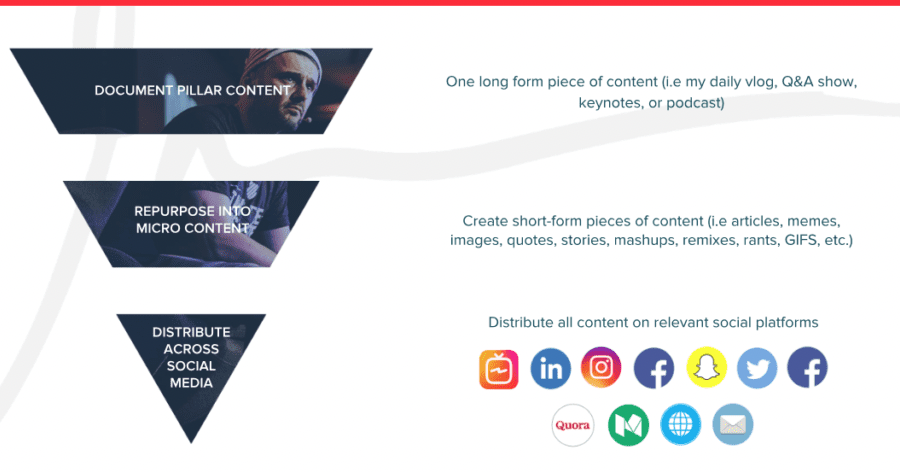5 ways to repurpose content like a professional creator
Every finished piece of content is the starting point for a dozen more.
You've worked hard to create something you're proud of. After hours of planning, production, and refining, you publish it on the internet.
Then, after a few celebratory moments, you sit down to start working on the next piece of content.
For many creators, this endless cycle is taken for granted. Passion projects devolve into hamster wheels because a critical piece is missing from their strategy.
What is it that top writers, YouTubers, and podcasters do differently that allows them to break the burnout cycle and squeeze the most value out of every single creation they release?
The answer is content repurposing.
What is content repurposing?
Repurposing is “the process by which an object with one use value is transformed or redeployed as an object with an alternative use value.” (Source)
Modern examples of this practice include turning used food jars into storage containers, abandoned warehouses into loft apartments, or recycled plastics into luxury handbags.
When this is applied to content, creators translate the original value of their content into different formats, thereby reaching more people in new ways.
If you’ve ever seen an image of a quote with a colorful background on Facebook or Instagram, you’ve seen content repurposing at work. In this simple example, a creator transformed a piece of text into a shareable image.

But this technique is only the tip of the iceberg.
Benefits of content repurposing
Here are a few reasons why creators love implementing this strategy.
- Allows you to spend more time on each piece of content since you're able to squeeze more value from every one produced.
- Enables you to reach new audiences who otherwise wouldn't have found your work because they only consume one format (e.g., a person who only listens to podcasts may discover your newsletter because you released an audio version).
- Establishes your authority on the topic because people associate broad distribution with importance.
- Increases the ROI of what you create (more reach, bigger audience, additional sales, and support).
- Boosts SEO rankings when done properly, such as publishing videos targeting the exact keywords found in your article or newsletter.
The benefits gained from transforming your content will be unique to your situation, audience, and business model. Experimentation is key because the upsides can be quite impressive!
Which content should you repurpose?
Not every piece of content you make needs to be repurposed. Just as not every abandoned warehouse would be a good solution for loft apartments.
Here are a few questions to help you decide whether or not a piece of content is worth repurposing.
- Is it evergreen? — Evergreen content, continually relevant information, is one of the best resources to transform because you can almost guarantee the value will carry over into any new format.
- Is it already popular? — Content that is already popular with your audience is another low-hanging fruit in the repurposing strategy. Since it's already well-liked in one format, it will likely attract new fans once it's transformed. Plus, you can ask your original audience to build momentum by sharing the repurposed version across their social media channels.
- Does it convert well? — If you have content that consistently feeds your business, whether by providing leads or sales, transforming it could amplify those results.
5 types of content repurposing
Let’s dive into the reason you’re here — to learn exactly how to take your published content and repurpose it into new formats, experiences, and products.
There are dozens of ways to repurpose content effectively, but all of them fall into 5 distinct categories. By organizing it this way, you'll be able to understand more quickly which avenues are a good fit for your content strategy.
#1. Syndicate
Syndicating content is reposting it, in its entirety, on different platforms.
Let's say you wrote a blog post explaining how to paint an accent wall. The original article lives on your main website so that you can benefit from organic search traffic over time.
However, there are many people who would benefit from your post that may never find your website. By syndicating your article, you bring the content to them.
- Post your article as an answer to a question on Quora.
- Repost on Medium (here's how to do this with Ghost + Zapier automatically).
- Post a relevant discussion piece on Reddit or Indie Hackers.
- Find relevant blogs in your niche and ask if you can repost your article as a guest post on their website.
The above examples deal with text, but the process can apply to any format. For video content, republish it to different social media channels (Facebook, TikTok, etc.). For audio content, make sure it’s available on a variety of listening apps (Apple, Google, Spotify, Stitcher, etc.).
Syndicating your content is more effective than sharing it because platforms favor "native" content. This means they're more likely to show people things that keep them on their respective websites rather than links that take them away.
#2. Transform the medium
The most powerful way to repurpose your content is to convert it from one medium to another, such as text into audio or visuals.
Here are the most common ways creators use this opportunity:
- Turn main points into a presentation (using a tool like SlideShare).
- Capture core elements into a single image or explanatory infographic (see Canva or Figma).
- Split apart the content into an automated email series.
- Create a video from audio or written content (tools like Descript or Wavve can help).
- Transcribe audio or video information into text and post it as an article.
- Record text content into a podcast.
- Walkthrough your content live on a webinar or live stream (see StreamYard).
The process of repurposing is gradual. One format can easily turn into another, which can be turned into something else after that, and so on.
Changing mediums opens the doors to entirely new platforms and audiences. Writers gain access to podcasting fans, podcasters are introduced to the YouTube community, and video producers enter the blogosphere.
Although this tactic requires more work, there are numerous tools and integrations which can help lighten the burden.
#3. Divide and conquer
Another repurposing strategy is to break your longer pieces of content into smaller chunks and spread them out across different platforms and social media.
Creators like Gary Vaynerchuk have grown rapidly by adopting this model.

Here are a few use cases:
- Split apart a long-form blog post into: multiple shorter articles on your site or a syndication platform, several tweets or tweet threads, an email course for new subscribers
- Divide a 20-minute YouTube video into a dozen YouTube shorts or TikTok videos, or a 4-part video course
- Chop up a 45-minute podcast interview into a 2-minute highlights reel, a 5-second clip shared on social
You can also combine repurposing strategies to create new opportunities. The 5-second podcast clip could be turned into a short video, or the tweet thread could be syndicated across platforms.
The goal is to think about every finished piece of content as the starting point for a dozen more.
#4. Seed future content
Old content sparks new ideas for creators all the time. One way to look at this method is as though older pieces are seeds that sprout and branch off into new forms of content when given the opportunity.
So, how does this relate to repurposing? Use the original content as the foundation for subsequent creations. A few examples are:
- Use a listicle post as the starting point for a new blog series where each list point is expanded upon.
- Take the content from a video or podcast and dive deeper into the topic either in a live webinar or through other videos/podcasts.
- Write a follow-up post that answers questions not addressed in the first article.
- Find a well-received piece of content and turn it into an annual series, such as income reports, goal trackers, or travel updates.
In addition to providing you with a constant stream of content ideas, this tactic can also improve your SEO with internal linking and increase the time visitors spend browsing your content (both of which will grow your business).
Repurposing aims to make your professional life easier by streamlining the process of making things. In most cases, that means reusing what you already have. In others, it means borrowing from what’s finished to create something brand new.
#5. Repackage
The final technique is to repackage your finished content into a larger, more valuable product.
Some common means of accomplishing this are:
- Creating an ebook by collecting and arranging multiple blog posts.
- Releasing an online course that organizes numerous published videos into an educational format.
- Building a resource hub from templates, links, and infographics spread across your website.
- Designing a FAQ page that links out to various podcast episodes or articles to answer questions more in-depth.
Repackaging content often includes changing its medium or expanding upon it, but both are optional depending on the objective. These repackaged goods make excellent lead magnets, income-producing products, and niche authority-builders.
How to start repurposing your content
It’s worth noting you can repurpose content of any size and format. You don’t need to write behemoth blog posts or record feature-length videos before you begin.
Take time to understand how repurposing fits into your larger content strategy. Are you in a phase where discovery and growth are your main objectives? Or do you have a sizable audience that’s ready to monetize?
Once you've decided your goals, review your published content and begin with the low-hanging fruits first, such as tweeting article excerpts or transcribing videos into blog posts. The simpler the task, the more likely it’ll get done.
Lastly, remember that being a creator is a long game. It takes time to find your voice, build a following, and make money with your work. Repurposing can help shorten that journey, but it’s not a magic button.
Focus on creating work you're proud of and sharing it with people who appreciate it, and you'll be well on your way to sustainable success.






